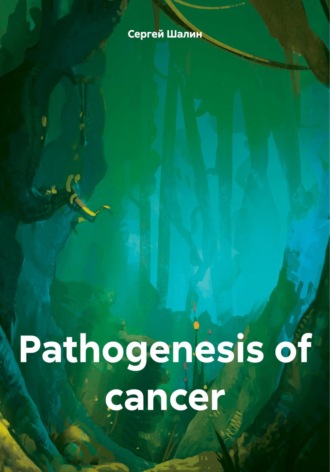
Сергей Алексеевич Шалин
Pathogenesis of cancer
MONONUCLEAR ONCOGENESIS PROGRAM
According to the modern theory of molecular genetic mechanisms of multistage carcinogenesis, the “birth” of a malignant cell occurs in three stages: initiation, promotion and progression. The program of the emergence, growth and development of mononuclear oncogenesis in the carrier organism consists of many regular, evolutionarily determined and successively changing periods and stages, separated in time, space and local changes in the cell (nucleus, cell membrane, cytoplasm). Detailed information about the molecular genetic mechanisms of oncogenesis is available in the available literature, so let us summarize and analyze its main provisions. To create the theory of “Mononuclear oncogenesis” as a natural mechanism of the emergence, growth and development of a malignant process, we considered it possible to question the existing theory about the origin of the primary malignant stem cell of solid tumors from cambial cells of the integumentary or glandular epithelium. After all, the question of what cellular and/or tissue substrate the malignant stem cells of solid tumors originate from is still debatable, and the range of cells that could lay claim to the role of the precursor cell of the primary malignant stem cell has not yet been precisely determined.
The first period is the formation of a “pre-tumor” bed.
The first stage:
– is the emergence and development of general diseases of the body, both basic and accompanying: nonspecific changes in tissues of an inflammatory, dystrophic and dishormonal nature; benign tumors; developmental defects; age-related changes, etc.
The second stage:
– is the emergence and development of pre-tumor pathological changes in local tissues: specific morphological, biochemical, immunological and other changes in local tissues in the zone of chronic inflammation. A “pretumor” bed is formed in the form of an isolated microcavity. At the same time, chronic inflammation stimulates hematopoiesis – proliferation of bone marrow mononuclear cells.
The second period is the “birth” of the primary malignant stem cell.
The first stage is initiation:
– in the red bone marrow, as a result of stimulation of hematopoiesis and under carcinogenic influence (ionizing radiation, exo- and endocarcinogens, viruses), a characteristic spectrum of disorders occurs at the gene, chromosomal and genomic levels: amplification (increase in the copy number of genes), deletions, insertions, translocations, micromutations (point substitutions, microdeletions, microinsertions), etc., of a pluripotent progenitor cell of the ancestor of myelopoiesis with subsequent development into a Monocyte lineage (Class II) or a unipotent progenitor cell of the ancestor of Monocytes (Class III) according to a recessive trait. An initiated cell appears – a mononuclear cell that has genotypic changes in nuclear DNA, but is phenotypically presented as a normal cell – a monocyte.
Initiation conditions:
– the use of the initiator should be one-time and short-term, and the occurrence of mutations depends on the dose of the initiator – the stronger the effect, the more reliable the result;
– initiation occurs only during cell mitosis, i.e. in the zone of natural intensive proliferation of somatic cells;
– initiation is more likely in the area of chronically increased proliferation, stimulated by external or internal influences;
– initiation is irreversible, i.e. mutations that occur at the level of nuclear DNA cannot be restored to normal;
– taking into account that embryonic features appear in a malignant cell, the proliferating zone must begin from the embryonic period of development of the organism, and also during the period of transformation of a normal proliferating somatic cell into a malignant cell, conditions similar to embryonic ones must be created;
– it is known that malignant cells have different levels of potency: from unipotent to pluripotent, that is, the level of activity of the progenitor cell when it transforms into a primary malignant stem cell must be quite high – unipotent or pluripotent;
– initiation must cease completely before the promoter can take effect, i.e. a change in the state of the cell is necessary: initiation must occur under certain conditions, but further influence (promotion) can be carried out when the cell with an altered genotype is already in other conditions of existence and microenvironment. Thus, a single and short-term carcinogenic effect leads to irreversible genotypic changes in the nuclear DNA of a proliferating somatic cell. However, initiation alone is not enough for the “birth” of a malignant stem cell.
Second stage promotions:
– in an isolated microcavity of a focus of chronic inflammation, an aggressive liquid in an oxygen-free environment affects the cell membrane and cytoplasm of a genotypically altered tissue mononuclear cell. Inside an isolated microcavity under conditions close to embryonic, there is a proliferating cellular composition fixed to the membrane or suspended. Structural changes in the cell membrane occur, with a violation of selective permeability for inorganic ions and “chemical evolution” in the cytoplasm of the genotypically changed Mononuclear cell – epigenetic changes.
Promotion terms:
– promotion is effective only after initiation and, moreover, after the complete cessation of the action of the initiator, i.e. the initiated cell must be in other conditions of existence and microenvironment – in the zone of chronic inflammation;
– the interval between initiation and promotion does not affect the final incidence of malignant neoplasms, i.e. the lifespan of an initiated cell can be different, but it is necessary that it be as long as possible (months);
– the promoter must influence the initiated cell continuously and for a long time, i.e. an initiated cell with a long life cycle must be in certain isolated conditions (super conditions), in which the aggressive effect on it can continue for a relatively long period (months);
– the promoter can influence the initiated cell in different ways, including the structure of the cell membrane with changes in selective permeability, the chemical state of the cytoplasm, cell differentiation, the possibility of blocking intercellular connections, etc.;
– promotion is reversible at the initial stage, i.e. early manifestations of promoter effects may disappear and the cell will return to its original state;
– genotypic and epigenetic changes in a proliferating somatic cell prepare the mechanism of transformation into a malignant stem cell and simultaneously trigger it. A prerequisite for the implementation of the transformation mechanism is sufficient isolation from the influence of the host organism;
– in an isolated microcavity of chronic inflammation, mitosis of a cancer cell precursor cell occurs, which has genotypic and epigenetic changes, and its transformation into a primary malignant stem cell. During mitosis, the transformation mechanism is realized as a continuous process consisting of two parts: the manifestation of the level of genotypic changes and the manifestation of the nature of genotypic changes;
– at the same time, an unstable active system is “born” – a primary malignant stem cell, which has retained many of the basic abilities and capabilities of the mother cell-precursor of the cancer cell, has not completely left the embryonic state and acquires new abilities in its new life.
Thus, a proliferating somatic cell, having genotypic changes in nuclear DNA, finds itself in “super conditions” of chronic inflammation, where it is exposed to long-term and continuous (months) aggressive influence in an oxygen-free environment. As a result, it acquires epigenetic changes – structural damage to the cell membrane and chemical changes in the cytoplasm. It is currently believed that genotypic and epigenetic changes in a proliferating somatic cell are preparatory and, at the same time, trigger for the mechanism of actual transformation into a malignant stem cell. A prerequisite for the implementation of the transformation mechanism is sufficient isolation from the influence of the host organism.
The third stage is progression (the actual transformation mechanism):
– the formation of a malignant “embryo” due to the proliferation of the primary malignant stem cell – in an isolated microcavity, mitosis of a tissue mononuclear cell occurs, which has genotypic and epigenetic changes and its transformation into a primary malignant stem cell. During mitosis, the transformation mechanism is implemented as a continuous process consisting of two parts:
– part one – manifestation of the level of genotypic changes: the return of the Mononuclear cell during mitosis to the embryonic state and the block of differentiation of daughter cells at the pluripotent or unipotent level, corresponding to the level at which genotypic changes in the nuclear DNA of the bone marrow stem cell occurred during hematopoiesis;
– part two – manifestation of the nature of genotypic changes: the spectrum of changes in nuclear DNA at the gene, chromosomal and genomic levels comes into force: amplification (increasing the copy number of genes), deletions, insertions, translocations, micromutations (point substitutions, microdeletions, microinsertions), etc. An unstable active system “emerges” – a primary malignant stem cell, which has retained many of the basic abilities and capabilities of the mother cell – the tissue mononuclear cell, which has not completely escaped from the embryonic state and acquires new abilities of its new life.
Thus, a proliferating somatic cell, which has primary mutations in the nuclear DNA of the genome as a result of initiation, then structural changes in the cell membrane and chemical changes in the cytoplasm as a result of promotion, turns into a primary malignant stem cell with subsequent progression.
The third period is the growth and development of the malignant process.
Stage first – formation of a malignant “embryo”: due to the proliferation of the primary malignant stem cell, the accumulation of similar or homogeneous malignant cells occurs within the shell of an isolated microcavity. Due to exposure growth, the size of the malignant “embryo” can increase significantly.
Stage second – organization of the primary malignant focus: with the release of malignant cells beyond the isolated microcavity into the intercellular space, subsequent proliferation, appositional and invasive growth, the organization and increase in the volume of the primary malignant focus occurs.
Stage third – organization of a secondary malignant focus – metastasis: invasive growth and angioneogenesis contribute to the penetration of malignant cells into the vascular bed and organization of a secondary malignant focus – metastasis.
The malignant process, as an independent system, is capable of self-organization and self-regulation. Throughout its growth and development, it is accompanied by deliberate death of cells and non-cellular structures, redistribution of water, autonomous regulation, malignant progression, increasing superiority, as well as control and subjugation of the host organism. To create the theory of “Mononuclear oncogenesis” as a natural mechanism of the emergence, growth and development of a malignant process, we considered it possible to question the existing theory about the origin of the primary malignant stem cell of solid tumors from cambial cells of the integumentary or glandular epithelium. After all, the question of what cellular and/or tissue substrate the malignant stem cells of solid tumors originate from is still debatable, and the range of cells that could lay claim to the role of the precursor cell of the primary malignant stem cell has not yet been precisely determined. Theoretically, any somatic cell can turn into a malignant cell. However, it is impossible to identify transformation processes in vitro and oncogenicity of cells in vivo, because The transformation of a normal cell into a malignant cell is a process initiated at the molecular level.



